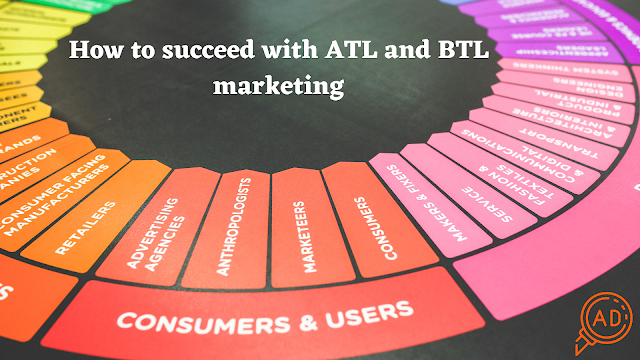How to succeed with ATL and BTL marketing
The advertising industry uses many strategies in the process of advertising a product or service or branding. Above-the-line (ATL) marketing and Below the line (BTL) marketing techniques is one among them which is carried out by many as it helps in reaching the maximum audience. Both marketing techniques vary in the medium of communication used and sometimes differ in prices/commissions charged by the advertising agencies with one common motive to increase brand awareness and generate sales to their client's businesses. Which marketing activity to choose entirely depends upon the marketing goals of the clients. There is a guarantee of maximum exposure amongst the public while opting for these two techniques.
ATL
The main function of ATL Selling Square is to grow goodwill and increase awareness. They square measure their Brobdingnagian campaigns, usually untargeted and widely spread. A good example of Associate ATL's marketing strategy is the national and possibly international TV movement, where equal stores are open to all audiences. The purpose of advertising is to broaden the brand's horizons, reach more people, and promote the brand with a targeted and transparent image, rather than targeting specific individuals previously perceived as accessible patrons. Print media and radio broadcasts are two other examples of his reaching a mass market of potential buyers.
These media also reach large numbers of people. ATL is a useful strategy for brand development and promotion, but determining its exact impact and ROI can be difficult. Because of this, it is more directionless. The goal is to increase awareness and brand awareness rather than targeting a specific conversion rate.
BTL
BTL applies inversely to ATL. The target audience for below-the-line marketing is narrowly defined as people identified as potential consumers. direct marketing, event sponsorships, and more. The latter has become particularly popular because providing potential customers with a memorable experience makes brands more memorable and more lovable to individuals.
Unlike ATL, BTL focuses on audience targeting, ensuring that ad placement and content best match audience intent. BTL differs from ATL in that it focuses more on ROI, tracking user conversions, and quantifying success. By devoting ourselves to our users and their needs, BTL aims to not only increase brand awareness but also secure direct customers for our products or brands. Engagement marketing like this usually yields results that are very easy to measure and track.
Though these two techniques come under advertising, it poses different characteristics.
1. BTL's main task is to initiate direct interaction with a particular group of audience through the targeted promotional campaign, on the other hand, ATL's task is to carry out in creating brand image and awareness through mass promotional activity.
2. Telemarketing, Sponsorships, Mailshots, Email marketing, Exhibition, Tradeshows, and other such offbeat mediums which mainly target a specific group of people are used in BTL whereas in TV shows, Radio, Print media, Internet, and other such conventional marketing mediums that promote a brand and create awareness among the audience are used in ATL marketing.
3. BTL marketing is used when the target audience is a specific region or a small group of people. ATL marketing is used when the advertising campaign is only focused on a large audience and has a large target audience.
4. BTL marketing, on the other hand, relies on two-way communication between marketers and customers to foster long-term relationships. On the other hand, ATL marketing is one-way communication where the audience is at the center of the message.
5. BTL marketing increases the point of sale as its motive is to generate sales whereas ATL marketing drives the customer response as it poses a larger audience.
6. Opting for BTL marketing mediums are comparatively less cost and budget-friendly than ATL marketing mediums as it covers a wider audience.
7. The language and messages used in communication are written in a way that is understandable and comprehensible to the audience in ATL marketing and BTL use specific, memorable, and direct means of communication to promote your products.
Every activity has both advantages and disadvantages on its own.
Now let's look into some advantages and disadvantages carried by ATL and BTL.
Advantages of ATL
ATL is a useful strategy for brand development and promotion, but determining its exact impact and ROI can be difficult. Because of this, it is more directionless. The goal is to increase awareness and brand awareness rather than targeting a specific conversion rate.
Disadvantages of ATL
While there are many benefits to investing in ATL advertising, there are also many downsides to this type of advertising. His one advertisement in popular mass media like television can cost millions and his marketing in offline mass costs much more than online advertising. This limits the number and duration of ads you can run, requiring you to use strategies that fit your budget. Due to the nature of this type of marketing, there is a lack of information about what consumers do after seeing an ad. Reports on potential viewers for TV and film ads, the projected number of people passing through billboards, and readership for print ads are all available. Still, these reports offer little insight into consumer behavior and preferences. These limitations make it difficult to determine the direct return on investment (ROI) of your advertising investment and may lead you to make uninformed decisions about future marketing budget investments and long-term strategies.
Advantages of BTL
Unlike ATL, BTL focuses on audience targeting, ensuring that ad placement and content best match audience intent. BTL differs from ATL in that it focuses more on ROI, tracking user conversions, and quantifying success. By devoting ourselves to our users and their needs, BTL aims to not only increase brand awareness but also secure direct customers for our products or brands. As such, engagement marketing tends to produce results that are very easy to measure and track.
Disadvantages of BTL
BTL marketing often requires more preparation and execution than ATL as it requires specific customer targeting data and dedicated staff to launch and manage these campaigns. To support content production and ad positioning, you should be familiar with the platforms and technologies used to launch BTL operations. Or you need more training. You also need to have a good understanding of your company's customer base. If your in-house marketing team is not available, you may need to hire a marketing firm to address these issues. This will increase the cost of your originally planned advertising spend.
Conclusion
It all depends on how well the marketer understands the market and whether the communication meets the customer's needs. Some business companies benefit from ATL activities, while others need to add BTL. ATL marketing focuses on brand building, while BTL marketing focuses on personalization and conversion through targeted direct marketing. As a result, BTL marketing targets targeted segments while ATL marketing targets undifferentiated segments. Feel free to contact us for further details bunkerintegrated.in
Call: +91 8079660238
Follow us on social media platforms
Instagram : https://www.instagram.com/bunkerintegrated/
Youtube : https://www.youtube.com/channel/UCXDepvv2YZ_tUeO-__AezQA
Pinterest : https://in.pinterest.com/bunkerintegrated/




Comments
Post a Comment